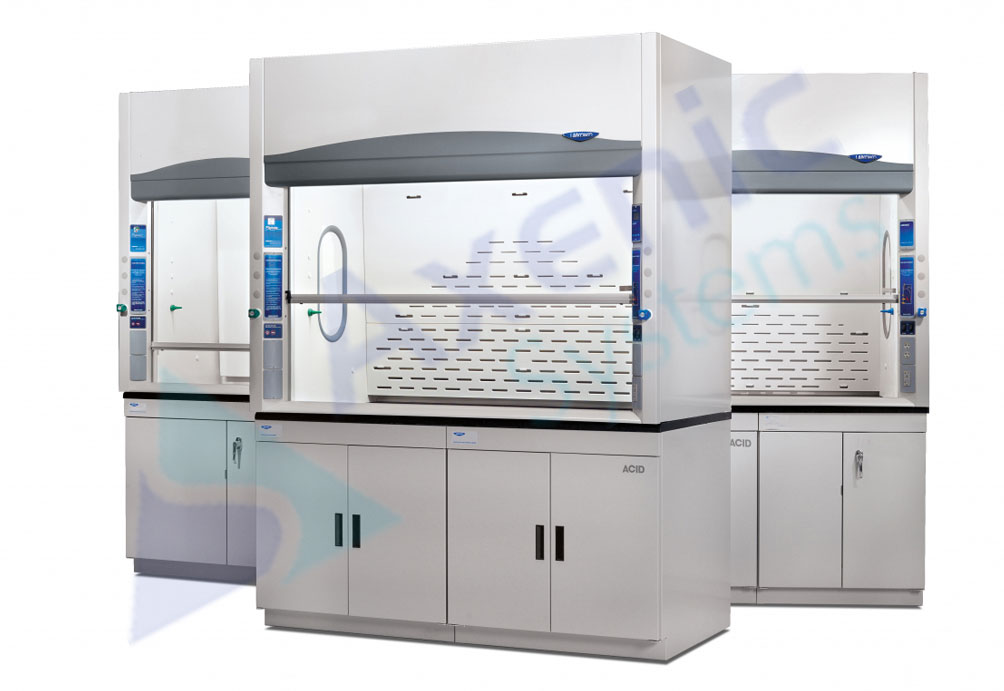Axenic System is one of the leading company engaged in architectural
designing, planning, installation, commissioning of HVAC and Turnkey
construction for cleanroom projects
Fume Hoods
Table of Contents

Introduction to Fume Hoods
AXENIC SYSTEMS (established in 1995) are certified manufactures and suppliers of Fume Hoods in India. The offered lab equipment is used to exhaust harmful chemicals, poisonous and toxic gases from laboratory compartments. A complete team from Architects to HVAC, Electrical, and Structural Consultants are well-equipped to plan and manage the project.
A fume hood is a distinctive type of laboratory work equipment with an attachment on top that contains the effects of the experiment being run inside it. Fume hood is functionally designed to ensure safety for the operator and other people in the cleanroom, and it filters out any harmful gasses. They provide safety from minor explosions or splashes. Fume hoods have a built-in mechanism to strongly suck the gasses out of the working area inside the enclosure. In simple words, A fume hood is an enclosure that carefully contains and ventilates hazardous fumes, vapours, gases and dust produced by chemical processes performed in the fume hood.
Working
The functions of a fume hood are as follows:
- To protect the user from gasping toxic fumes.
- To protect the experiment or sample from impurity.
- To protect the operator from explosions or spills.
To achieve the above, a fume hood has three major parts ‒ the table, the enclosure, and the system.
The table is generally a standard CRCA made C-frame or H-Frame work, with under-table storage like secured cabinets and/or drawers, where you can keep some lab equipment. The attachment is CRCA-made with a glass shutter at one side. The glass in the shutter is of good quality with some advanced models that are explosion-proof.
The air suction system is normally placed on top of the box or on the backside (the side towards the wall). This system is usually made up of a strong exhaust fan or air pump and accompanying air duct. The strength of the pump lies in the airflow strength starting from 4 to 8 meters per second to more.
When the exhaust is running, it draws in volumes of air through the open side (never run the exhaust with the hood entirely closed) and vents it through the duct. The duct may throw the fumes right outside the room in the air, or may run it through a filtration system, depending upon the harshness of the experiment.
Specifications of Fume Hoods
| Working Size (ft.) | 4′ x 2′ x 2′ | 5′ x 2′ x 2′ | 6′ x 2′ x 2′ | 7′ x 3′ x 3′ | 8′ x 3′ x 3′ |
| MOC | CRCA 18G Epoxy Powder Coated | ||||
| Stand | M.S Pipe (18G) Powder coated | ||||
| Working Table Top | M.S Powder Coated Sheet Covered with P.P Sheet | ||||
| Exhaust System | Motor Blower Assembly Covered with G.I Sheet | ||||
| Door / Sash | Door vertical Folding Type. | ||||
| Air Velocity | ≥0.5m/s | ||||
| Noise Level | 65dBA | ||||
| Glass Window | Two layer toughen glass, 5mm thickness, Motor Control, height adjustable | ||||
| Make-up Air | Air needed to replace the air exhausted from a room by the fume hood and other ventilation devices. | ||||
| Face Velocity | The velocity of the air passing through the work opening of the fume hood measured in the plane of the sash. Measured in feet per minute (fpm), or liters per minute. | ||||
| Electrical Fittings | Electrical Sockets & MCB Switch | ||||
| Illumination | Fluorescent Lamp or UV Lamp | ||||
| Optional | – HEPA Filter – Caster wheels – Horizontal sash – SS 314 / SS 316 MOC – Temperature indicator – Face Velocity Meter – Airflow Indicator – Audio / Visual alarm |
||||
| Power source | 220 / 230 Volts | ||||
Construction of Fume Hoods
Our fume hoods come with dual wall construction made of Stainless Steel or Epoxy Coated Mild Steel as required by the client. It is ensured that the peripheral is matched with the base unit. The internal walls and baffles are made of moulded reinforced thermoset epoxy resins that meet or exceed NFPA 45 standard on Fire protection for labs using chemicals. The jambs are radiuses and smoothly designed to diminish the turbulence as the air enters the hood. The construction materials of our fume hoods are used as mild steel, type 304 or 316 stainless steel (Epoxy Coated).
Application
- A laboratory fume hood is extensively used in several analytical chemistry labs where experiments that release toxic gases like sulphur dioxide gas are released.
- It is perfect for performing experiments that include chemicals that easily sputter out during heating. Such compounds can easily burn the lab technician and other lab inhabitants when conducted in the open space.
- The other type of experiments that should be conducted inside a fume hood are ones that involve combustible chemicals. These chemicals can be lethal when exposed to the air.
- Vaporizers, carcinogens, and other volatile chemicals are handled inside this enclosure.
